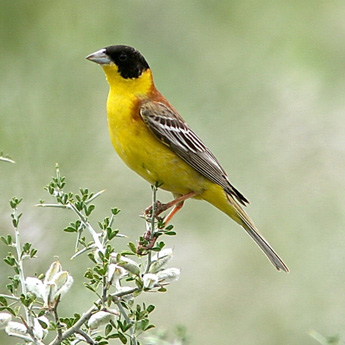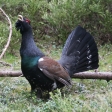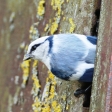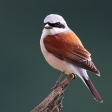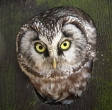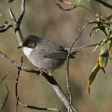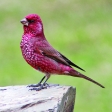The area around the Northern Adriatic supports some of the highest levels of biodiversity of any area in Europe. There are several reasons for this including its position at the centre of Europe, close to the influence of both the Italian and Balkan peninsulas, steppe and steppe-like areas to the east and the vast temperate landmass of Eurasia.
Added to this is the, climate, enormously variable over relatively short distances as a result of the Alpine arc (the Dolomites, Carnic, Julian and Dinaric Alps) lying so close to a warm shallow sea, the Adriatic. Average annual rainfall varies from less than 800mm a year in parts of southern Istria to more than 3300mm in the foot-hills of the Julian Alps, points just 100 miles (160km) apart. Average annual temperatures are equally varied over even shorter distances with a mild 15.7°C in Trieste set against less than 7°C in Tarvisio just over 60miles (100km) away. As one moves away from the coast northeastwards the temperature gradient here is steeper than anywhere else in Europe.
The result of this is that Ural Owls and Three-toed Woodpeckers nest less than 10 miles (15 km) from the first pairs of Sardinian and Subalpine Warblers and sometimes even closer bird species such as Bee-eaters and Hoopoes are less than an hour away by car from Ptarmigans and Pygmy Owls.
This avian biodiversity is mirrored in that of the rest of the flora and fauna with, for example, almost 200 species of butterfly and where some single 10 x 10 km squares contain as many species of plant as are found in Great Britain & Ireland.
We have several tour ideas from 1 day up to 2 week long programmes, fantastic Birding & Culture mix as well. See one of them below.
{backbutton}
Fact File
-Istria is a very interesting corner of Europe shared by 3 countries, Slovenia, Croatia and Italy
-short distances, great variety
Highlights
-visit of 3 countries with small distances and big variety
-high elevation mountain species such as Ural Owl, Three-toed Woodpecker, Pygmy Owl, Ptarmigan & lower Mediterranean species such as Subalpine Warbler, Sardinian Warbler, Bee-eater, Hoopoe are very close to each other
-Julian Alps with Wallcreepers, Alpine Accentors, Alpine Choughs, Water Pipits, Ptarmigan and the occasional Snow Finch
Accommodation
-at each area the main point is to be at a perfect birding spot so accommodation varies from bed and breakfast to agritourist guesthouses and small hotels
Price
Ask for the actual price.
Our price includes:
- all travel as noted in the itinerary;
- all accommodation based on shared rooms (most rooms are twin bedded), at most locations there are single rooms as well for extra charge (Please ask for a single room at the time of booking!);
- 3 meals per day, generally breakfast at the accommodation, packed lunch, dinner (consists of at least two courses);
- services of the leader(s);
- trip materials.
Not included:
- flights to and from Budapest;
- optional programmes to places of interest and entrance fees involved;
- airport and other departure taxes, tips;
- food beyond generally 3 meals/day mentioned in the itineraries;
- excess baggage charges;
- telephone calls;
- alcoholic beverages;
- compulsory personal insurance.
If you have questions about the inclusion of any cost item, please contact us.
Activity level
- Generally easy to moderate walks, but there are some mountainous trails as well
- Lots of onsite wildlife observing possibilities
- Weather generally favourable
Itinerary
Birding & Wildlife Itinerary
The area around the Northern Adriatic supports some of the highest levels of biodiversity of any area in
|
Added to this is the, climate, enormously variable over relatively short distances as a result of the Alpine arc (the Dolomites, Carnic, Julian and Dinaric Alps) lying so close to a warm shallow sea, the Adriatic. Average annual rainfall varies from less than 800mm a year in parts of southern Istria to more than 3300mm in the foot-hills of the |
The area covered by the tour |
The result of this is that Ural Owls and Three-toed Woodpeckers nest less than 10 miles (15 km) from the first pairs of Subalpine and Sardinian Warblers and sometimes much less and birds such as Bee-eaters and Hoopoes are less than an hour away by car from Ptarmigans and Pygmy Owls.
This avian biodiversity is mirrored in that of the rest of the flora and fauna with, for example, almost 200 species of butterfly and where some single 10 x 10 km squares contain as many species of plant as are found in
Southern Slovenia (days 1 & 2 – day 3 optional)
|
The Logar Agritourism |
We are based at the Logar Agritourism, a very comfortable farm-based hotel in the village of Žerovnica next to Cerkniško Jezero, a karstic polje covering more than 3,000 hectares which floods regularly and plays host to a wide range of birds. It is an Important Bird Area. In spring and early summer the lake-bed is usually well-inundated, with nesting Red-necked Grebes and Bitterns while the surrounding wetland areas are host to Corncrakes, Spotted and Little Crakes, Savi’s Warblers, Barred Warblers, Whinchats, Scarlet Rosefinches and Snipe, all set in some of the most beautiful landscapes in Europe.
|
Cerkniško Jezero “full”
|
The lake is surrounded by limestone mountains, part of the The local farmland and villages are also a joy to behold with “common” species such as Fieldfare, White Stork, Spotted Flycatcher and Skylark in excellent numbers. |
Ural Owl – photo Domen Stanič |
To the south-west, and covering 8,000 km2 split and between Croatia and Slovenia lies Istria, a peninsula of fabulous landscapes, a glorious climate and wonderful biodiversity, rich in birds, especially Mediterranean ones.
|
The karstic rockface above the hotel |
We are based at Istarska Toplice, a thermal spring resort in northern Istria, set in the countryside against the impressive backdrop of karst rockfaces and caves with nesting Alpine Swifts and right in front of an extensive riparian From early the area is host to an extraordinary display of Fireflies (Luciola italica) as well as being rich in orchids and butterflies. |
The
|
The eastern side of Istria, between the Italian border and the city of These sites are threatened by scrubbing over but several are now being grazed once again. |
Rock Partridge hangs on in the Karst |
NW Istria has its own jewels too and as the River Mirna reaches the sea the riverine forest gives way to open agricultural land and, finally, lagoon, saltmarsh, reedbeds and the open sea. Here one can find the most northerly breeding Black-headed Buntings in Europe but Rollers, Lesser Kestrels and Red-rumped Swallows often oversummer and the latter bred in 2015. Short-toed Eagles often hunt for snakes along the river and Spanish Sparrows are frequent around some of the farms.
(days 6 & 7, day 8 optional)
|
The Caneo Hotel at the mouth of the River Isonzo |
|
The main birding site is Isola della Cona on the opposite bank a short distance away. Here a freshwater marsh has been recreated with hides and screened paths and an enormous number of species can be added relatively quickly including Pygmy Cormorants, Purple Herons, Little Bittern, Black-winged Stilt, Avocet and Bee-eaters at their breeding colony in just a few minutes. The other species on show depend very much on the time of year but the area is a magnet for migrating waders and terns and Ruff, Spotted Redshank, Black, White-winged Black and Whiskered Tern are all regular in April and May and several usually oversummer.
|
There are a large number of wetland and karst sites to visit very close by, depending on priorities, together with a large cast of supporting wildlife, especially butterflies including Southern Festoon, Large Copper and False Ringlet and flowering plants in breathtaking displays before the summer sun dries out many of the sites.
|
Large Copper butterfly |
NW
Just 90 minutes from the Adriatic and still within the Isonzo/Soča catchment lie the Julian Alps, rising to more than 2,500 metres above sea-level and straddling the borders of Italy Austria and
We are based at the Jazebec Bed & Breakfast, a very comfortable and quiet base in the village of Idrsko, close to Kobarid and the site of the famous battle of Caporetto in November 1917 and nestling below the mountains of Krn and Stol, the latter being our first destination.
|
Stol is a long ridge in the Julian pre-Alps overlooking the Italian plain to the south-west and the true |
|
The following day we head further inland towards the town of Bovec and thence to the road leading up onto the mountain of Mangart, the third highest peak in Slovenia and the only one with a tarmac road leading to over 2000 metres above sea-level.
|
Ptarmigan are present on Mangart |
Mangart is a massive attraction for botanists and lovers of the Alpine flora from across Europe and beyond as it gives easy access to one of the most interesting parts of the eastern The flora is simply magnificent, depending upon the season and includes large drifts of Alpenrose, various gentian species. Other fauna include the Alpine Marmot and an east |
Our base is approximately two hours from




